3.2.1 - Particles
5.0(8)
5.0(8)
Card Sorting
1/42
Earn XP
Description and Tags
Study Analytics
Name | Mastery | Learn | Test | Matching | Spaced |
|---|
No study sessions yet.
43 Terms
1
New cards
Specific Charge
The ratio of the charge of a particle to its mass measured in C/kg.
\
Specific Charge = Charge / Mass
\
Specific Charge = Charge / Mass
2
New cards
What is the Strong Nuclear Force?
The strong nuclear force holds protons and neutrons together to overcome electrostatic forces of repulsion between protons to keep the nucleus together (stable).
3
New cards
Strong Nuclear Force - range
0 - 0.5 fm = repulsive
0\.5 - 3 fm = attractive
>3 fm = no effect
0\.5 - 3 fm = attractive
>3 fm = no effect
4
New cards
What is a femtometer?
1 fm = 1 x 10^-15 m
5
New cards
Alpha decay
When the nucleus of an atom emits an alpha particle (2 protons and 2 neutrons)
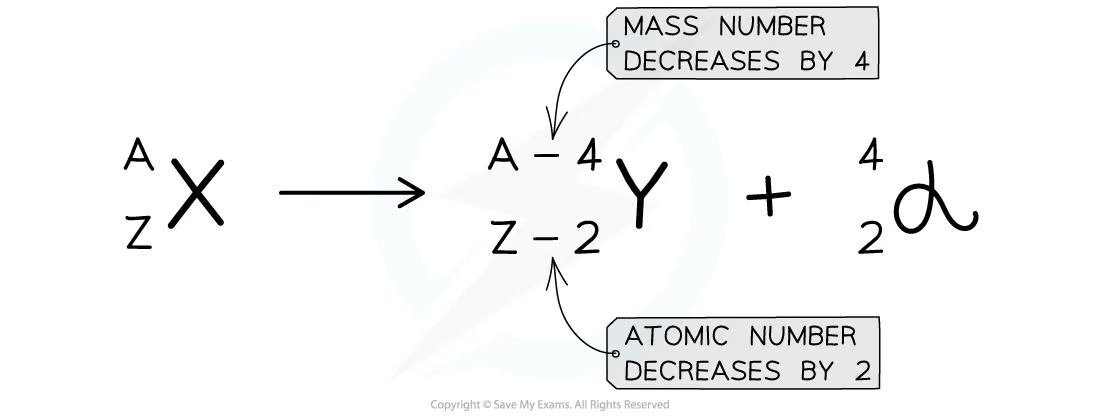
6
New cards
Beta (minus) decay
When a neutron in the atom converts into a proton - during which a beta particle (an electron) and an electron anti-neutrino are emitted from the nucleus.

7
New cards
Why were neutrinos theorised?
The conservation of energy in Beta decay.
\
Beta particles emitted had a range of energies up to a maximum so another particle had to be emitted also to conserve the amount of energy lost by the nucleus.
\
Beta particles emitted had a range of energies up to a maximum so another particle had to be emitted also to conserve the amount of energy lost by the nucleus.
8
New cards
What is an antiparticle?
For every particle, there is an antiparticle with equal mass and rest energy but all other properties are opposite - e.g charge.
9
New cards
Antiparticle examples
electron - positron
proton - antiproton
neutron - antineutron
neutrino - antineutrino
proton - antiproton
neutron - antineutron
neutrino - antineutrino
10
New cards
What is a Photon?
A small packet of EM radiation. The energy of a photon is given by the eqn:
\
E = hf
\
h - planck’s constant
f - frequency
\
E = hf
\
h - planck’s constant
f - frequency
11
New cards
What is annihilation?
When a particle and its corresponding antiparticle meet they annihilate and all their mass gets converted into energy in the form of two photons (to account for the conservation of momentum).
12
New cards
Annihilation Equation
2hf = 2E
\
the combined energy of the photons = the rest energy of the particle - antiparticle pair.
\
therefore -
\
hf = E
\
the combined energy of the photons = the rest energy of the particle - antiparticle pair.
\
therefore -
\
hf = E
13
New cards
Pair Production
If a photon with sufficient energy passes near an electron or nucleus then it can be converted into a particle - antiparticle pair; these then move away from each other.
14
New cards
Pair Production - Equation
hf = 2E
\
one photon produces a particle and antiparticle.
\
one photon produces a particle and antiparticle.
15
New cards
The Four Fundamental Forces
Gravity
Electromagnetic
Strong Nuclear Force
Weak Nuclear Force
Electromagnetic
Strong Nuclear Force
Weak Nuclear Force
16
New cards
Gravitational Force
Gravity affects any particle with mass over an infinite range.
\
Its exchange particle is the graviton.
\
Its exchange particle is the graviton.
17
New cards
Electromagnetic Force
The EM force affects any charged particle over an infinite range.
\
Its exchange particle is the (virtual) photon.
\
Its exchange particle is the (virtual) photon.
18
New cards
Strong Nuclear Force/ Interaction
The SNF affects hadrons only over a range of 0 - 3fm.
\
Its exchange particle is the gluon.
\
Its exchange particle is the gluon.
19
New cards
Weak Nuclear Force/ Interaction
The WNF affects all particles over a range of up to 10^-18 m.
\
Its exchange particle is the W+ or W- Boson.
\
It is responsible for Beta decay, electron capture and electron - proton collisions.
\
Its exchange particle is the W+ or W- Boson.
\
It is responsible for Beta decay, electron capture and electron - proton collisions.
20
New cards
What are Exchange Particles?
They carry energy and momentum between the particles experiencing the force.
\
e.g repulsion can be imagined as two people throwing a ball between them causing them both to be pushed apart due to momentum; the ball is the exchange particle.
\
e.g repulsion can be imagined as two people throwing a ball between them causing them both to be pushed apart due to momentum; the ball is the exchange particle.
21
New cards
WNF - Beta minus Decay
A nucleus converts into a proton and emits a W- boson which then decays into an e- and electron anti neutrino.

22
New cards
WNF - Beta plus Decay
A proton converts into a neutron and emits a W+ boson which decays into a positron and an electron neutrino.
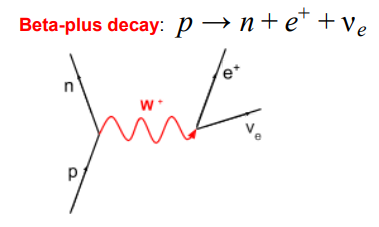
23
New cards
WNF - Electron Capture
When an atomic e- is absorbed by a proton, a neutron and electron neutrino are emitted.
\
The W+ boson is the exchange particle.
\
The W+ boson is the exchange particle.
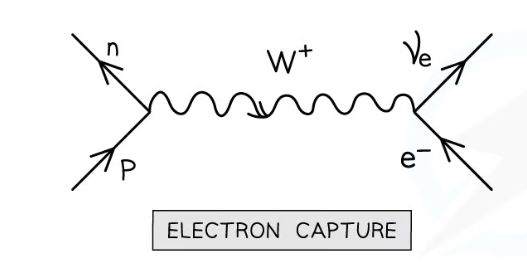
24
New cards
WNF - electron proton collisions
When an electron and proton collide, a neutron and electron neutrino are emitted.
\
The W- boson is the exchange particle.
\
The W- boson is the exchange particle.
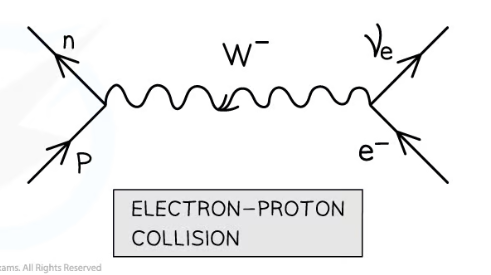
25
New cards
Classification of particles
All particles are either hadrons or leptons.
26
New cards
What is a hadron?
A hadron is a sub-atomic particle that interacts through the SNF and is made up of quarks. There are two types of hadron:
\
Baryons & Antibaryons
Mesons
\
Baryons & Antibaryons
Mesons
27
New cards
Baryons
Particles made up of three quarks.
\
They have a baryon number of +1. Protons (uud) and neutrons (dud) are both examples of baryons
\
They have a baryon number of +1. Protons (uud) and neutrons (dud) are both examples of baryons
28
New cards
Antibaryons
Particles made up of three antiquarks.
\
They have a baryon number of -1.
\
They have a baryon number of -1.
29
New cards
Baryon decay
All baryons eventually decay into protons as this is the most stable baryon.
30
New cards
Mesons
Mesons are quark - antiquark pairs such as kaons or pions. They’re the exchange particle for the Strong Nuclear Interaction.
31
New cards
Pions
**π+** = up and anti-down quark.
**π^0** = up , anti-up or down, anti-down, or strange, anti-strange.
**π-** = down and anti-up quark.
**π^0** = up , anti-up or down, anti-down, or strange, anti-strange.
**π-** = down and anti-up quark.
32
New cards
Neutral Pion Decay
As neutral pions are made by quarks and antiquarks of the same ‘flavour’ they annihilate and form two photons.
33
New cards
Charged Pion Decay
Decay into a muon and an antimuon neutrino (**negative pion**) or a antimuon and a muon neutrino (**positive pion**).
34
New cards
Kaons
Kaons are another type of meson that last longer before decaying than pions; they’re produced by the SNF and decay via the WNF as they’re *‘strange’* particles.
\
**K+** = up and anti-strange quark.
\
**K^0** = down and anti-strange quark.
***(anti)*** **K^0** = strange and anti-down quark.
\
**K-** = strange and anti-up quark.
\
**K+** = up and anti-strange quark.
\
**K^0** = down and anti-strange quark.
***(anti)*** **K^0** = strange and anti-down quark.
\
**K-** = strange and anti-up quark.
35
New cards
Kaon decay
Kaons decay into pions or directly into (anti)muons and the equivalent (anti)muon neutrinos.
36
New cards
Quarks
Quarks are the fundamental particles that all hadrom=ns are composed of. There are three main quarks (up, down and strange).
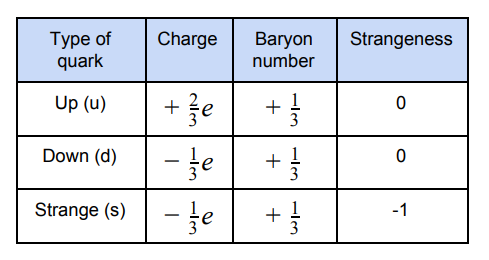
37
New cards
Leptons
Leptons are fundamental particles - they cannot be broken down further. Examples include the muon or the electron.
\
They **do not** experience the SNF.
\
They **do not** experience the SNF.
38
New cards
Muons
Muons are negatively charged and have a mass 200x bigger than the electron so is often referred to as a ‘heavy electron’.
\
It has a corresponding antimuon (µ+), muon neutrino and antimuon neutrino.
\
It has a corresponding antimuon (µ+), muon neutrino and antimuon neutrino.
39
New cards
Muon decay
Muons decay into electrons (or positrons) and the corresponding (anti)electron neutrino.
40
New cards
Lepton Number
Leptons have a lepton number = 1
Antileptons have a lepton number = -1
Non-leptons have a lepton number = 0
Antileptons have a lepton number = -1
Non-leptons have a lepton number = 0
41
New cards
Baryon Number
Baryons have a baryon number = 1
Antibaryons have a baryon number = -1
Non-baryons have a baryon number = 0
Antibaryons have a baryon number = -1
Non-baryons have a baryon number = 0
42
New cards
Strangeness Number
Anti-strange particles have a strangeness number = 1
Strange particles have a strangeness number = -1
Non-strange particles have a strangeness number = 0
Strange particles have a strangeness number = -1
Non-strange particles have a strangeness number = 0
43
New cards
Conservation Rules
During particle interactions, the following must always be conserved:
\
* Energy and Momentum
* Charge
* Baryon Number
* Lepton (electron and muon) Number
\
Strangness is conserved during the SNF but during the WNF it may change by 0, -1 or +1.
\
* Energy and Momentum
* Charge
* Baryon Number
* Lepton (electron and muon) Number
\
Strangness is conserved during the SNF but during the WNF it may change by 0, -1 or +1.